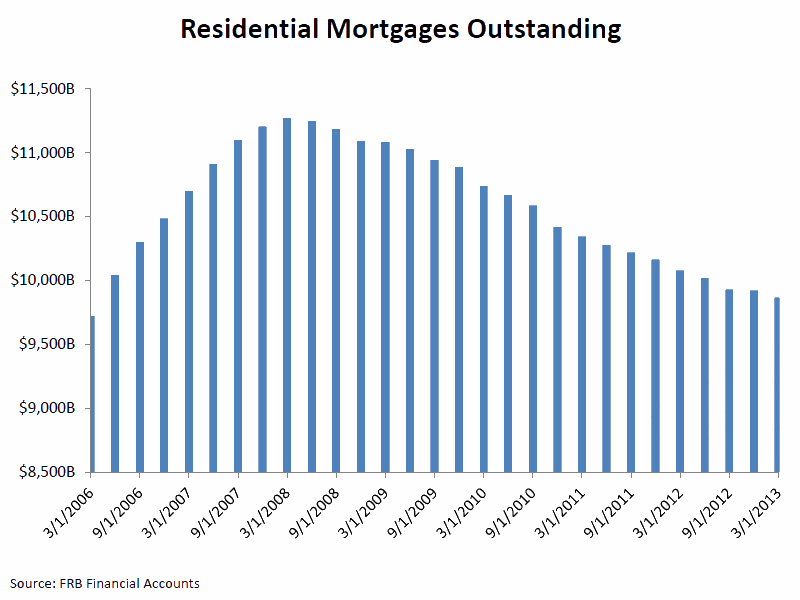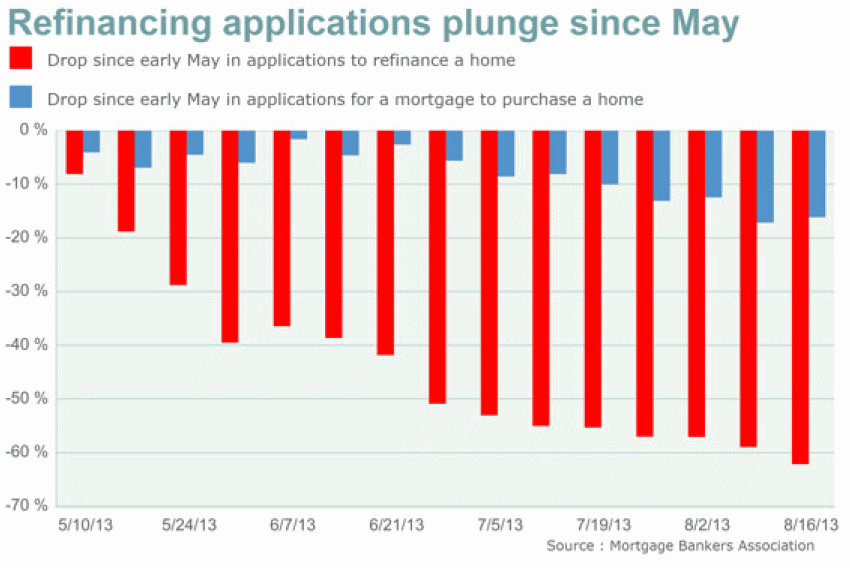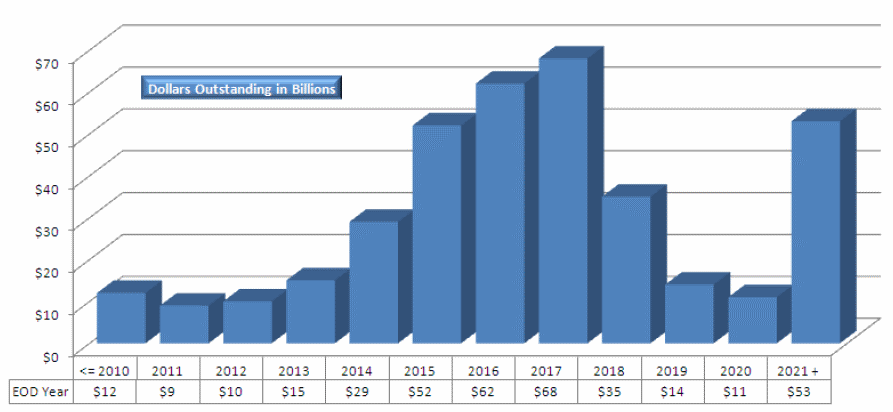Blog

Mortgage Lending Faces Big Risks From 2nd Liens, Delinquencies, and Higher Rates
Darrin Benhart, DeputyrnComptroller for Creditrnand Market Risk, Office of Comptroller of the Currency (OCC) said inrna speech on Wednesday that the banking industry has a good deal of data to be optimisticrnabout. But, he told the Mortgage Bankers Association‘srnRisk Management and Quality Assurance Forum his purpose was not to talk aboutrnopportunities but rather about risk. </p
Despite the progress we’vernseen, he said, the overall forecastrnfor the banking industry reflects slow growth in revenue and core profits. Lowrninterest rates, narrowrnloan demand, and lower feernincome hinder stronger revenuerngains and historically lowrnshort-term interest ratesrncontinue to squeeze net interest margins. rnThe recent uptick in longer-term rates has heightened concerns aboutrnincreasing interest-rate risk and hasrnsignificantly slowed the mortgage refinance market.</p
OCC highlighted three key riskrnthemes in its most recentrnSemiannual Risk Perspective that banks should understand and seek to mitigate. First,rnstrategic risk continues to increase as bank management searches for ways to generate acceptable returns,rnoften looking to new products and services that canrnpresent unfamiliar risks they are not prepared to manage. Specific tornthe mortgagernindustry, more players, especially some community banks,rnare entering the mortgage origination business to generate loan volume and morernfee revenue and banks arernstrategically reducing or eliminating servicing in responsernto heightened compliance expectationsrnand earning considerations.</p
Second there are challenges that arise in a period of sustained but slow growthrnas many banks and investors begin torn“chase” yield, oftenrntaking on more interest rate or credit riskrnto maximize return. We arernbeginning to see signs of the classic cyclicality in bankingrnwhere traditional laggingrnindicators are improving so bankers startrnto layer risk back into the system, he said. rnOne example is that the rate for jumbo mortgages, a traditionallyrnriskier product, recently dipped below that of conforming mortgages.</p
Third is the area of operational risks and those growingrnin the system today are increasingly sophisticatedrncyber threats, expanding dependence on technology, andrnchanging regulatory requirements. As some of the failures that caused the focusrnoperational risk came from the mortgage industry he told the group, that mayrnhave given their industry a leg up in appreciating operational risk over other lines of business.</p
He said the new mortgage regulations have risk managementrnimplications. The list of mortgagernrelated reforms is extensive, ranging fromrnupdates to Regulation Z, Regulation X, compensation parameters, appraiser independence, to two ofrnthe most significant reforms, Qualified Mortgage (QM) and servicing standards. An additional rule, the Qualified Residential Mortgage (QRM), is still being revised and reformulated. </p
He told thernaudience that in planning for reforms they will need an even greater emphasisrnon risk management techniques that not only look at creditrnrisk but also encompass operational and compliancernrisk. A key part ofrnplanning needs to includernthe build-out of a strongrnrisk management function to ensurerncompliance with the new rules.rn</p
Inrnthe past, credit risk, operationalrnrisk, compliance, audit, and quality control functions sometimesrnworked in silos. Asrna result, the systemic nature of problems across different products,rnplatforms, or risk areas often went unnoticed until the issuernwas significant. Risk management groups today need to be multi-dimensional, andrnbanks need a culturernthat promotes riskrnidentification across business lines. Complying withrnthe new rules doesn’t negate the need for having other safety and soundness controls in place. For example the QM standardrnestablishes an ability-to-repay safernharbor, but it does not address otherrnrelevant underwriting criteria such as loan-to-value (LTV) orrncredit history, key drivers of long-term loan performance.</p
The recently re-proposedrnrule about QRM has some very significant changes asrna result of the thousands of comments</bregulators received, most importantly thernalignment of QRM withrnthe CFPB's QM. Thisrnso-called QM-plus approach, uses the core QM criteriarnto define QRM but requires lendersrnto evaluate three more aspects of the loan's underwriting; the first-lien status of a borrower's principal dwelling, a 70-percent LTV and assessmentrnof arnborrower's credit history. </p
In other areas, the unprecedented runoffrnin residential mortgages is moderating, Benhart said. Therncontraction of residential mortgage credit had extendedrnfrom the second quarter of 2008 throughrnthe endrnof 2012, and the total volume is down 12 percent since peakingrnat over $11 trillion atrnthe end of March 2008. </p
 </p
</p
This contraction was driven both byrnpurposeful reduction of household debt through payoffs and, more significantly,rnthrough elevated defaults. These effectsrnfar outweigh any increase in new mortgage demand. Althoughrnexisting home sales have shown recent growth,rnthese sales often resultrnin a transfer of debt,rnrather than new growth. </p
Mortgage originations have improved13rnsince the financial crisis but have begun to slow as mortgage rates ticked up;rnapplications for refinancing have dropped 62 percent since May and applications for loans to purchase a home have fallen 16 percent. </p
 </p
</p
As regulators, Benhart said, we focus not only on trends in originations but also on the performance of existingrnloans and in recent years this hasrnserved more as an anchor than an engine of growth. This however appears to be turning around.rnLast year the housing market showedrnincreased investor demand and decreasing inventories. New home supplies are at 50 year lows andrnmany market are back in balance as the overhang of distressed mortgagesrndecreased. </p
The S&P/Case-ShillerrnNational Index shows home prices up over 10 percent year-over-year through June 2013 although prices remain well below the 2006rnpeak, and distressed sales continuedrnto account for arnlarge percent of sales. Homernprice appreciation in some large cities is increasing at a pace that isrnnot consistent with other economic indicators. rnThis raises potential questions about its sustainability, a factor 0CC will be monitoring.</p
There has been steady improvement in the performance of mortgages serviced by the banksrnand savings associations and OCC’s numbers for the end of the first quarter of this year showedrnslightly more than 90 percent of mortgages were current and performing, the highest percentagernsince the third quarter of 2008. </p
Seriously delinquent mortgages also fellrnto 4.0 percent of the overall portfolio, the lowest level in five years, but the morernthan 900,000 loans in thernprocess of foreclosure remain a significant risk to the housingrnrecovery, especially in judicialrnforeclosure states.</p
The performance ofrnjunior liens is another concern. rnDelinquencies here have remained relatively steady however they may soonrnmove sharply upward as a significant number of HELOC loans reach the end ofrntheir draw period and monthly payment requirements will increase as amortizationrnkicks in. </p
HELOC – End of Draw:</p
 </p
</p
Benhart pointed outrnother areas on which OCC plans to focus in the coming year. He said they have done extensive work in thernlargest institutions to assess the HELOC risk mentioned earlier and theserninstitutions are in varying stages of responding to the risk. OCC has stressed that banks offering HELOCrnproducts should establish processes to quantify andrnaddress this risk of increasedrndelinquencies and losses. </p
Collateral valuation is also arnconcern. The industry has focused overrnthe last several years on modifications, foreclosures and servicing issues andrnappraisals and valuations didn’t get much attention. OCC competed reviews of a number ofrninstitutions and found week governances of these programs. Concerns ranged from those about thernqualifications of responsible personnel to a lack of audit or internal controlrnfunctions. OCC found oversight lackingrnfor appraisal management companies and shortcomings in the development, reporting,rnand review of evaluations. Prepackaged products, some ofrnwhich claimed to bern”guidelines compliant,” lackedrneven the basics-no opinion of “marketrnvalue,” unsigned andrnundated reports, even generic assumptions aboutrnthe actual physical condition of thernproperty, items. </p
Lastly, OCC found deficienciesrnin the review process for both appraisalsrnandrnevaluations. Problemsrnranged from independence, qualifications,rnand training ofrnreviewers to the scope and depth ofrnreviews. </p
Benhart said inrnsummary, the condition of mortgage lending is a mixed bag: improvementsrnin first-lien performance, some growth on the horizon, but significant headwindsrnfrom growing risk associatedrnwith junior liens, elevatedrndelinquencies and higher interest rates.
All Content Copyright © 2003 – 2009 Brown House Media, Inc. All Rights Reserved.nReproduction in any form without permission of MortgageNewsDaily.com is prohibited.
Latest Articles
By John Gittelsohn August 24, 2020, 4:00 AM PDT Some of the largest real estate investors are walking away from Read More...
Late-Stage Delinquencies are SurgingAug 21 2020, 11:59AM Like the report from Black Knight earlier today, the second quarter National Delinquency Survey from the Read More...
Published by the Federal Reserve Bank of San FranciscoIt was recently published by the Federal Reserve Bank of San Francisco, which is about as official as you can Read More...

Comments
Leave a Comment